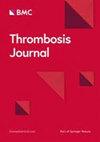Exercise transiently increases the density of incipient blood clots in antiplatelet-treated lacunar stroke patients
IF 2.6
4区 医学
Q2 HEMATOLOGY
引用次数: 0
Abstract
Older individuals and, in particular, individuals at risk of recurrent stroke, may be susceptible to thrombosis when participating in exercise, however, this aspect has not been well investigated. Clot microstructure and conventional markers of thrombotic risk were determined in twenty lacunar stroke patients and fifteen healthy age-matched controls before, immediately after and 1 h after a bout of moderate intensity cycling exercise. Data were analyzed using a linear mixed model approach. At rest, clot microstructure (1.69 ± 0.07 vs. 1.64 ± 0.05, corresponding to a difference of ~ 50% in normalized clot mass; p = 0.009) and thrombocyte count (73%; p < 0.0001) were higher, and activated partial thromboplastin time was lower (18%; p = 0.0001) in stroke patients compared to age-matched controls. Acute exercise increased thrombogenic markers similarly in the two groups: incipient clot microstructure (1.69 ± 0.07 vs. 1.74 ± 0.05; p = 0.0004 and 1.64 ± 0.05 vs. 1.71 ± 0.04; p < 0.0001, for stroke and controls respectively), plasma fibrinogen (12%; p < 0.0001 and 18%; p < 0.0001, for stroke and controls respectively) and the combined coagulation factors II, VII and X (p = 0.0001 and p < 0.0001, for stroke and controls respectively). The results show that exercise transiently increases the risk of blood clot formation in both stroke patients and controls, however, due to the higher baseline thrombogenicity in stroke patients, the post exercise risk of forming blood clots may be higher in this group. Registered at ClinicalTrials.gov (NCT03635177).运动可短暂增加经抗血小板治疗的腔隙性中风患者的初期血凝块密度
老年人,尤其是有复发性中风风险的人,在参加运动时可能容易发生血栓,但这方面的研究还不多。本研究测定了 20 名腔隙性中风患者和 15 名年龄匹配的健康对照者在进行中等强度自行车运动前、运动后和运动后 1 小时内的血栓微观结构和血栓风险的常规指标。数据采用线性混合模型方法进行分析。与年龄匹配的对照组相比,中风患者在静息状态下的血凝块微观结构(1.69 ± 0.07 vs. 1.64 ± 0.05,相当于标准化血凝块质量相差约 50%;p = 0.009)和血小板计数(73%;p < 0.0001)较高,活化部分凝血活酶时间较低(18%;p = 0.0001)。急性运动增加了两组患者的血栓形成标志物:初期血栓微结构(1.69 ± 0.07 vs. 1.74 ± 0.05; p = 0.0004 和 1.64 ± 0.05 vs. 1.71 ± 0.04; p < 0.0001,分别为中风和对照组)、血浆纤维蛋白原(12%;p < 0.0001 和 18%;p < 0.0001,分别为中风和对照组)以及联合凝血因子 II、VII 和 X(p = 0.0001 和 p < 0.0001,分别为中风和对照组)。结果表明,运动会短暂增加中风患者和对照组形成血栓的风险,但由于中风患者的基线血栓形成率较高,该组患者运动后形成血栓的风险可能更高。已在 ClinicalTrials.gov 注册(NCT03635177)。
本文章由计算机程序翻译,如有差异,请以英文原文为准。
求助全文
约1分钟内获得全文
求助全文
来源期刊

Thrombosis Journal
Medicine-Hematology
CiteScore
3.80
自引率
3.20%
发文量
69
审稿时长
16 weeks
期刊介绍:
Thrombosis Journal is an open-access journal that publishes original articles on aspects of clinical and basic research, new methodology, case reports and reviews in the areas of thrombosis.
Topics of particular interest include the diagnosis of arterial and venous thrombosis, new antithrombotic treatments, new developments in the understanding, diagnosis and treatments of atherosclerotic vessel disease, relations between haemostasis and vascular disease, hypertension, diabetes, immunology and obesity.
 求助内容:
求助内容: 应助结果提醒方式:
应助结果提醒方式:


